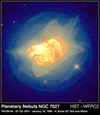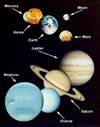 The interstellar gas cloud
The interstellar gas cloud
Over the ages, many theories have been advanced as to the origin of the
Sun and planets. The current theory for the origin of the Solar System
suggests that the formation of the Solar System began with the collapse
of an interstellar gas and dust cloud, with a mass slightly larger than
the present mass of the Sun. This cloud included material from earlier
supernova explosions of stars, as it was rich in the heavier elements
that make up much of the planetary material in the Solar System.
The collapse of the cloud caused it to rotate, increasing in speed as the cloud contracted. As the contraction continued, the cloud flattened and a disc formed around a central core of condensed matter. This configuration, known as a solar nebulae, would have resembled the shape of a typical spiral galaxy but was much smaller.
 As the gas and dust was pulled in toward the central condensation,
the potential energy of the gas and dust was converted to kinetic energy
as it was pulled towards the centre of the cloud and the temperature of
the nebulae began to rise. Eventually, the temperature became great enough
in the centre of the cloud for nuclear reactions to begin, thereby giving
birth to a star, our Sun.
As the gas and dust was pulled in toward the central condensation,
the potential energy of the gas and dust was converted to kinetic energy
as it was pulled towards the centre of the cloud and the temperature of
the nebulae began to rise. Eventually, the temperature became great enough
in the centre of the cloud for nuclear reactions to begin, thereby giving
birth to a star, our Sun.
 Formation of the planets and moons
Formation of the planets and moons
The material in the disc continued to collide and gradually formed larger
and larger objects. At this stage, the formation of planets split into
two types. Those close to the newly forming Sun, where the temperature
was too high for water and ice to exist, and those further from the centre
at the distances of Jupiter and beyond, where the colder conditions allowed
ice to form.
The planets forming close to the Sun could not hold onto their lighter more volatile molecules and elements, leaving the heavier molecules and elements like iron and the silicates to form the inner planets. There was much less heavier metals and silicate material than water available in the gas nebulae so the inner planets had less material from which to form and as a consequence formed much smaller and denser planets than their Jovian brothers.
The outer Jovian planets forming in the solar nebulae at lower temperatures
where ice could  form
were able to acquire much more mass than planets forming closer to the
Sun. Once a planet achieved a large enough mass it could attract and retain
large amounts of hydrogen and helium from the surrounding space. Hydrogen
and helium are by far the most abundant elements in the Universe, and
so planets forming further out in the nebulae become very massive indeed.
form
were able to acquire much more mass than planets forming closer to the
Sun. Once a planet achieved a large enough mass it could attract and retain
large amounts of hydrogen and helium from the surrounding space. Hydrogen
and helium are by far the most abundant elements in the Universe, and
so planets forming further out in the nebulae become very massive indeed.
The formation of the inner planets, including the Earth, was complete within 100 million years of the collapse of the interstellar gas cloud. The bombardment of planetary and satellite surfaces by debris left over from the initial formation of the planets continued for another 600 million years, adding small quantities to the original size of the planets. Such collisions still continue to take place today, but are much less frequent.
Rings and moons of the gas planets
In the outer Solar System, the availability of ice led to the formation
of giant planets with large gravitational fields. These planets were so large that each planet started
with its own nebulae of gas and dust rotating the central planet, eventually
forming the large number of satellites or moons. The formation of planetary
rings around Jupiter, Saturn and Neptune is probably due to the large
gravitational fields exerted by these huge planets preventing the formation
of moons near to the planet, leaving rings of gas, ice and dust.
gravitational fields. These planets were so large that each planet started
with its own nebulae of gas and dust rotating the central planet, eventually
forming the large number of satellites or moons. The formation of planetary
rings around Jupiter, Saturn and Neptune is probably due to the large
gravitational fields exerted by these huge planets preventing the formation
of moons near to the planet, leaving rings of gas, ice and dust.
Asteroids and comets
At some point after most of the planets had formed, a sudden increase
in solar activity and a subsequent increase in the intensity of the solar
wind cleared much of the remaining gas and dust out of the Solar System.
Some larger debris remained to form asteroids and comets. The rapid growth
of Jupiter and its large gravitational field apparently prevented the
formation of a planet in the region between Jupiter and Mars, leaving
instead thousands of asteroids.
The comets are representative of the material found in the outer Solar System. Most are extremely small, but some have been measured to be up to 400 kilometres in diameter. It is believed that billions of comets may exist far beyond Pluto.
Pluto and Charon
Pluto and its moon Charon are enigmas and are probably large comet type
objects or moons displaced from their original orbits, by a close encounter
with a larger planet. There is now much excitement about objects beyond
Pluto. Over the last few years, more and more small bodies have been found
orbiting the Sun at very great distances. The existence of these icy objects
was suggested by astronomer Gerard Kuiper some 50 years ago; because of
this, we call this collection of objects the Kuiper Belt.
It is generally agreed that the Solar System started to form around 5 billion years ago, with the Earth forming some 4.6 billion years ago. This is much younger than the Universe, which is now thought to be 12 - 15 billion years old.
| Copyright owned by the State of Victoria (Department of Education and Early Childhood Development). Used with Permission. |
|
|||||||||||||||||||||||